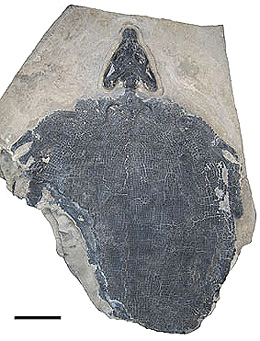Research Abstract
カメの背甲は内骨格起源
The endoskeletal origin of the turtle carapace
2013年7月9日 Nature Communications 4 : 2107 doi: 10.1038/ncomms3107

カメのボディプランは、一体型の頑丈な甲を持つ点において他の四肢動物のものと大幅に異なっている。カメの甲の背側部分(背甲)は主に肋板と椎板と呼ばれる骨甲板で構成され、肋板はその下の胴肋に、椎板は脊柱にそれぞれ繋がっている。しかし、背甲は体の表面に位置することから、これらの骨甲板要素の進化的起源ははっきりしていなかった。本論文では、比較形態学的解析および胚発生解析によって、背甲の主要部分は皮骨要素を含まず、内骨格である肋骨だけに由来することを明らかにする。今回カメ胚の発生過程を観察したところ、肋板および椎板は真皮内で発生せず、より深層の、肋骨や肋間筋の原基が発生する結合組織内で発生することがわかった。また我々は、系統的にカメの外群に相当する化石種についても調べ、カメの背甲に相当する構造が真の皮骨とは独立して発生する証拠を確認した。これにより、これまで不明瞭だったカメの甲の初期進化の一端が明らかとなった。
平沢 達矢1, 長島 寛2 & 倉谷 滋1
- 理化学研究所 発生・再生科学総合研究センター 形態進化研究グループ
- 新潟大学 医歯学総合研究科 生体機能調節医学専攻 機能再建医学講座 肉眼解剖学分野
The turtle body plan, with its solid shell, deviates radically from those of other tetrapods. The dorsal part of the turtle shell, or the carapace, consists mainly of costal and neural bony plates, which are continuous with the underlying thoracic ribs and vertebrae, respectively. Because of their superficial position, the evolutionary origins of these costo-neural elements have long remained elusive. Here we show, through comparative morphological and embryological analyses, that the major part of the carapace is derived purely from endoskeletal ribs. We examine turtle embryos and find that the costal and neural plates develop not within the dermis, but within deeper connective tissue where the rib and intercostal muscle anlagen develop. We also examine the fossils of an outgroup of turtles to confirm that the structure equivalent to the turtle carapace developed independently of the true osteoderm. Our results highlight the hitherto unravelled evolutionary course of the turtle shell.

